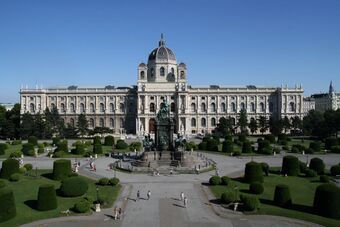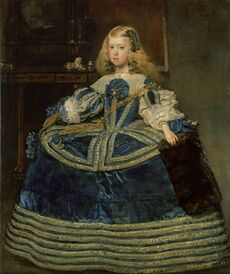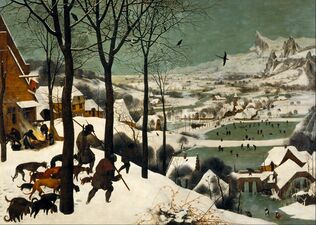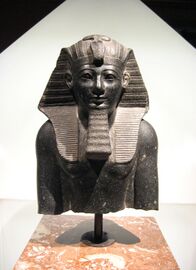متحف تاريخ الفنون
 | |
 Kunsthistorisches Museum in Vienna with Maria-Theresien-Platz | |
Interactive fullscreen map | |
| تأسس | 1871–1891 |
|---|---|
| الموقع | Maria Theresien Platz Vienna, Austria |
| الإحداثيات | 48°12′13.97″N 16°21′41.76″E / 48.2038806°N 16.3616000°E |
| النوع | Art museum |
| الزوار | 1,745,070 (2019)[1] |
| المدير | Sabine Haag (since 2009) |
| الموقع الإلكتروني | www |
The Kunsthistorisches Museum (lit. "Museum of Art History", often referred to as the "Museum of Fine Arts") is an art museum in Vienna, Austria. Housed in its festive palatial building on the Vienna Ring Road, it is crowned with an octagonal dome. The term Kunsthistorisches Museum applies to both the institution and the main building. It is the largest art museum in the country and one of the most important museums worldwide.
Emperor Franz Joseph I of Austria-Hungary opened the facility around 1891 at the same time as the Natural History Museum, Vienna which has a similar design and is directly across Maria-Theresien-Platz.[2] The two buildings were constructed between 1871 and 1891 according to plans by Gottfried Semper and Baron Karl von Hasenauer. The emperor commissioned the two Ringstraße museums to create a suitable home for the Habsburgs' formidable art collection and to make it accessible to the general public. The buildings are rectangular, with symmetrical Renaissance Revival façades of sandstone lined with large arched windows on the main levels and topped with an octagonal dome 60 metres (200 ft) high. The interiors of the museums are lavishly decorated with marble, stucco ornamentation, gold-leaf, and murals. The grand stairway features paintings by Gustav Klimt, Ernst Klimt, Franz Matsch, Hans Makart and Mihály Munkácsy.[3]
Collection
Picture gallery
The museum's primary collections are those of the Habsburgs, particularly from the portrait and armour collections of Ferdinand of Tirol, the collections of Emperor Rudolph II (the largest part of which is, however, scattered), and the collection of paintings of Archduke Leopold Wilhelm, of which his Italian paintings were first documented in the Theatrum Pictorium.
Notable works in the picture gallery include:
- Jan van Eyck: Portrait of Cardinal Niccolò Albergati (ح. 1431)
- Antonello da Messina: San Cassiano Altarpiece (1475–1476)
- Raphael:
- Madonna of the Meadow (1506)
- St Margaret and the Dragon (1518)
- Albrecht Dürer:
- Avarice (1507)
- Adoration of the Trinity (1511)
- Titian:
- The Bravo (1516–17)
- Portrait of Isabella d'Este (1534–1536)
- Lorenzo Lotto: Madonna and Child with Saint Catherine and Saint James (ح. 1527)
- Tintoretto: Susanna and the Elders (1555–56)
- Pieter Brueghel the Elder:
- The Fight Between Carnival and Lent (1559)
- Children's Games (1560)
- The Tower of Babel (1563)
- The Procession to Calvary (1564)
- The Gloomy Day (February - March) (1565)
- The Return of the Herd (October - November) (1565)
- The Hunters in the Snow (December - January) (1565)
- The Peasant and the Nest Robber (Bauer und Vogeldieb), 1568
- The Peasant Wedding (1568/69)
- The Peasant Dance (1568/69)
- Giuseppe Arcimboldo:
- The Four Seasons
- Summer (1563)
- Winter (1563)
- The Four Seasons
- Michelangelo Merisi da Caravaggio:
- The Crowning with Thorns (ح. 1602–1604)
- Madonna of the Rosary (1606–07)
- David with the Head of Goliath
- Peter Paul Rubens:
- Miracles of St. Francis Xavier
- Angelica and the Hermit (1626–1628)
- Ildefonso Altarpiece (1630–1632)
- Self-Portrait (1638–39)
- The Fur (1638)
- Rembrandt: Self Portrait (1652)
- Johannes Vermeer: The Art of Painting (1665–66)
- Diego Velázquez: Several portraits of the Spanish royal family, a branch of the Habsburg, sent to Vienna.
- Adrien Manglard: Seestück; Seehafen
- Thomas Gainsborough: Landscape in Suffolk (1748; currently not on display)
The collections of the Kunsthistorisches Museum:
- Egyptian and Near Eastern Collection
- Collection of Greek and Roman Antiquities
- Collection of Sculpture and Decorative Arts
- Coin Collection
- Library
Hofburg
- Ephesus Museum
- Collection of Ancient Musical Instruments
- Collection of Arms and Armour
- Archive
- Secular and Ecclesiastical Treasury (in the Schweizerhof)
Others
- Museum of Carriages and Department of Court Uniforms (in Schönbrunn Palace)
- Collections of Ambras Castle (in Innsbruck)
- the Austrian Theatre Museum in Palais Lobkowitz
Also affiliated are the:
- Museum of Ethnology in the Neue Burg (affiliated in 2001);
- Lipizzaner-Museum in the Stallburg
Nazi-looted art
In 2010, an Austrian government panel recommended that the Kunsthistorisches Museum should restitute two altar panels by the 16th-century Dutch artist, Maerten van Heemskerck to the heirs of Richard Neumann, a Jewish art collector in Vienna plundered by the Nazis.[4]
In 2015, a dispute over a painting by Pieter Bruegel the Elder, The Fight Between Carnival and Lent (1559), erupted between Poland and Austria. Poland presented evidence that the painting had been seized by Charlotte von Wächter, the wife of Krakow's Nazi governor Otto von Wächter, during the German occupation of Poland.[5] The Kunsthistorisches Museum, insisted that it had owned the painting since the 17th century, and that the artwork seized by von Wächter in 1939 "was a different painting".[6]
Recent events
One of the museum's most important objects, the Cellini Salt Cellar sculpture by Benvenuto Cellini, was stolen on 11 May 2003 and recovered on 21 January 2006, in a box buried in a forest near the town of Zwettl. It was featured in an episode of Museum Secrets on the History Channel. It had been the greatest art theft in Austrian history.[7]
The museum is the subject of Johannes Holzhausen's documentary film The Great Museum (2014), filmed over two years in the run up to the re-opening of the newly renovated and expanded Kunstkammer rooms in 2013.
From October 2018 through January 2019 the museum hosted the world's largest-ever exhibition of works by Pieter Bruegel the Elder called Bruegel – Once in a Lifetime.[8]
Gallery
Cupola of museum
Cupid the Honey Thief, drawing by Albrecht Dürer
The Crowning with Thorns by Caravaggio
David with the Head of Goliath by Caravaggio
Suleiman the Magnificent by Titian
Statue of Thutmosis III
A loving cup of King Ladislaus IV of Poland
Self-portrait by Rembrandt
Madonna of the Rosary by Caravaggio
See also
References
- ^ "Bundesmuseen: Die meisten Besucher in KHM, Belvedere und Albertina" [Federal museums: Most visitors go to the KHM, Belvedere and Albertina]. Der Standard (in الألمانية). Vienna. Austria Press Agency. 30 January 2020. Retrieved 31 October 2020.
- ^ The Office of the High Chamberlain (31 December 1906). Guide to the Treasury of the Imperial House of Austria. Vienna: A. Holzhausen. p. 12.
- ^ Czerny, Ernst (2012). "Gustav Klimt and Egyptian Art. Paintings in the staircase of the Kunsthistorisches Museum". Egypt and Austria VII. Academy of Performing Arts in Prague. ISBN 978-8073312473.
- ^ Hickley, Catherine. "Austria Urges Return of Altar Panels to Jewish Heir". www.lootedart.com. Bloomberg. Retrieved 2021-04-07.
A passionate collector, Neumann amassed more than 200 art works in his Vienna villa. He escaped Austria after the Nazi annexation via Switzerland to Paris. When the Nazis occupied France, he fled by foot through the Pyrenees to Spain. From there he reached Cuba, where he settled, and participated in the 1954 founding of an art museum in Havana. He later moved to New York to be with his daughter, and died there in 1961, age 82. Neumann's artworks were seized by the Nazis, then released shortly afterward to allow a sale to the Kunsthistorisches Museum in Vienna. Neumann's daughter sold the altar panels in 1938. The money went into a frozen account to pay Neumann's "emigration tax."
- ^ "Row erupts over £50m Bruegel painting in Nazi looted art claim". Art Law & More (in الإنجليزية). 2015-10-26. Retrieved 2021-04-07.
- ^ "$77 Million Bruegel Painting in Nazi Loot Claim". Artnet News (in الإنجليزية الأمريكية). 2015-10-23. Archived from the original on 2015-10-24. Retrieved 2021-04-07.
The Kunsthistorisches Museum in Vienna, meanwhile, claims that it has owned the painting since the 17th century, and that the artwork seized by von Wächter in 1939 was a different painting.
- ^ "Police find stolen £36m figurine". BBC News. 22 January 2006. Retrieved 31 October 2020.
- ^ "The Best of Bruegel – Only in Vienna" (in الإنجليزية). Kunsthistorisches Museum. Retrieved 31 October 2019.
External links
 Media related to متحف تاريخ الفنون at Wikimedia Commons
Media related to متحف تاريخ الفنون at Wikimedia Commons- Official website (in إنگليزية)
- Photoartkalmar.com: Spherical panorama of entrance
- Flickr.com: Hofburg's Armory photo gallery
- Virtual tour of the Kunsthistorisches Museum provided by Google Arts & Culture
خطأ لوا في وحدة:Authority_control على السطر 278: attempt to call field '_showMessage' (a nil value).
- Pages using gadget WikiMiniAtlas
- CS1 الألمانية-language sources (de)
- CS1: Julian–Gregorian uncertainty
- CS1 الإنجليزية الأمريكية-language sources (en-us)
- Short description is different from Wikidata
- Coordinates on Wikidata
- Official website different in Wikidata and Wikipedia
- Articles with إنگليزية-language sources (en)
- Kunsthistorisches Museum
- Museums of ancient Rome in Austria
- Museums of Ancient Near East in Austria
- Buildings and structures in Innere Stadt
- Museums in Vienna
- Art museums and galleries in Vienna
- 19th-century architecture in Austria
- صفحات مع الخرائط























